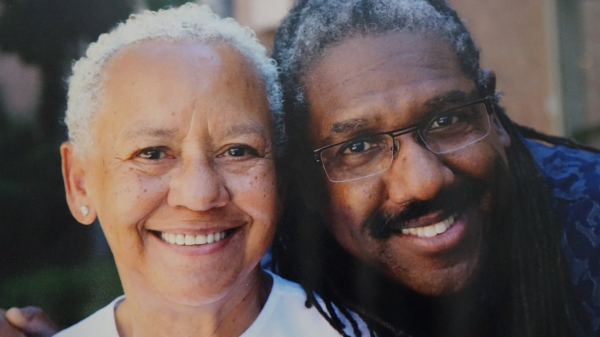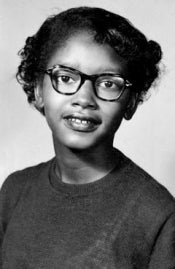History remembers the bold.
Alexander the Great, Marie Curie and Neil Armstrong are all remembered for their audacity, discoveries and exploration. But sometimes, a figure slips through the cracks.
While Rosa Parks is celebrated for her refusal to give up her bus seat, Claudette Colvin’s identical act of defiance in the same city nine months earlier has been all but forgotten.
With a research focus on the freedom struggles of people of color, the carceral state, oral history, and activism and social movements, Katherine Bynum, ASU Online assistant professor in the School of Historical, Philosophical and Religious Studies, examines why Colvin escaped the recognition — and the notoriety — that transformed Parks into a symbol of the Civil Rights Movement.
Colvin, a 15-year-old high school sophomore and straight-A student, regularly took the bus to get to and from school and would have seen and experienced the mistreatment of African Americans in the segregated South.
On March 2, 1955, when the bus she was riding became overcrowded and the driver asked her to vacate her seat, Colvin refused.
In Montgomery, Alabama, the city ordinance to segregate bus passengers by race had been in place since 1900. Although the law stipulated that no passenger would be required to move or give up their seat if the bus was overcrowded, by 1955, bus drivers routinely demanded that Black passengers stand or move seats to accommodate white passengers, and threatened arrest if they didn’t comply.
As a member of the local NAACP Youth Council, Colvin had a burgeoning interest in civil rights activism.
“Youth Council chapters informed residents of their civil rights,” Bynum said. “Because Colvin belonged to this youth chapter, she was a lot more informed than perhaps other people were at that time. She knew the law; she knew she wasn’t in violation, and she was very much aware that what she was doing was the right thing to do.”
After being arrested for refusing to give up her seat, Colvin revealed that she was pregnant.
“Respectability, especially for Black women, was a big significant issue within the Civil Rights Movement,” Bynum said. “There were a lot of critics that could derail any type of activism that didn’t come from this ‘respectable’ figure.”
Civil rights leaders worried that an unwed teenager couldn’t provide the respectable figurehead the movement needed.
In contrast, Parks was a seasoned civil rights organizer within the NAACP. She had a long-established career working with various local civil rights figures. When the opportunity presented itself again, months later, she was the ideal choice.
We spoke to Bynum about Colvin’s forgotten role in the pivotal Montgomery bus boycott and her participation in the federal lawsuit that would ultimately strike down bus segregation as unconstitutional.
Question: Why was Colvin arrested for refusing to give up her seat on a bus?
Answer: The law at the time stipulated that white and colored passengers could not sit across from one another. When Colvin got on the bus, she sat in the “colored” section, but the color line was breached when the bus picked up additional white passengers. The bus driver demanded that Colvin and the woman next to her, Ruth Hamilton, who was visibly pregnant, move seats to make room.
Both Colvin and Hamilton refused to move, and the police were called. When Colvin again refused to move upon the arrival of the two officers, she was arrested and forcibly removed from the bus. She was then booked into the city jail for violating Montgomery’s segregation laws. Later, Colvin was found guilty of assault and battery of a police officer even though law enforcement testified she was in no way abusive during her arrest. For violating the state’s segregation laws, she was sentenced to indefinite probation.
Q: How did Colvin's arrest help define the course of the Civil Rights Movement?
A: Unbeknownst to Colvin, the Women’s Political Council, led by Jo Ann Robinson, had been planning a bus boycott in Montgomery for over a year. After Colvin’s arrest, they decided to shelve that idea and instead appeal directly to the city and bus officials.
Black residents formed the Citizens Coordinating Committee, also led by Robinson. The committee spread awareness of Colvin’s arrest and met with local officials to discuss easing the city’s segregation ordinance, but they remained unmoved.
Several months later, on Dec. 1, 1955, Rosa Parks was arrested for refusing to give up her seat on a public bus. The following week, the NAACP and Women’s Political Council began promoting a bus protest in response to Parks’ arrest. The Montgomery bus boycott, as it came to be known, would last 382 days.
Q: Colvin’s arrest unified interests among Black residents who wanted an end to the humiliating treatment of African Americans on public transit in the Jim Crow South, so why don’t we know her name?
A: Initially, civil rights activists thought Colvin could be the ideal symbol for their fight. She wasn’t the first Black woman arrested for violating the city bus segregation laws, but she was the first to plead innocent and challenge the city in court.
However, in the months following her arrest, it was revealed that Colvin was pregnant. Her unwed and pregnant status stepped out of the bounds of respectability for Black womanhood in the 1950s, and as an unwed teenage mother, she could have been a divisive figure for the community. Also, she was dark-skinned and working-class — her mother was a maid and her father was a yard man — and lived in one of the poorest neighborhoods in town. Even though Colvin could have been the ideal symbol for a working-class community, the movement wanted a symbol that would be broadly appealing to the national public. They worried that the press would have used her circumstances to discredit and derail those efforts.
Q: How did Colvin’s act of defiance ultimately help end racial segregation on buses?
A: Colvin’s testimony in a federal lawsuit resulted in a November 1956 decision that bus segregation was unconstitutional under the Equal Protection Clause of the 14th Amendment to the U.S. Constitution.
A year prior, Black community leaders hoped to use Colvin’s case in a first-of-its-kind federal lawsuit to challenge racial segregation on city buses. The state attorney general dropped Colvin’s original state segregation charge to prevent this from happening.
But later, as the Montgomery bus boycott got underway and as Parks’ case got tied up in the Alabama state courts, a young Black attorney, Fred Gray, approached Colvin, Aurelia Browder, Susie McDonald and Mary Louise Smith to be named as plaintiffs in a new federal case.
Browder had been arrested for refusing to relinquish her bus seat to a white patron one month after Colvin’s arrest. McDonald had been arrested for violating bus segregation law, and Smith for refusing to give up her seat — both two months before Parks’ act of protest.
The federal court case filed by Gray, known as Browder v. Gayle, went before a three-judge panel of the United States District Court in June of 1956. The court ruled that the bus segregation laws were unconstitutional, and in November of 1956, the United States Supreme Court upheld the landmark decision when it was appealed by the state. Finally, in December of 1956, just over a year after the Montgomery bus boycott began, the Supreme Court ordered Alabama to desegregate its buses.
It wouldn’t have been possible without Colvin’s initial arrest and her subsequent testimony before the district court.
More Arts, humanities and education

ASU's Neal Lester reflects on life, death of poet Nikki Giovanni
When Neal Lester heard on Monday that poet and activist Nikki Giovanni had died, the news hit hard.Lester, the founding director of Arizona State University’s Project Humanities and a Foundation…

Learning by stepping outside
By Adriana MaestasAmid a world increasingly captivated by all things digital, more than 200 Arizona teachers have crafted immersive educational experiences that nudge students to step away from their…

Behind the curtain: Discovering careers in the arts at ASU Gammage
For a group of students from Sunnyslope High School, Eastmark High School and AZ Teen Homeschool Co-op, a recent December day at ASU Gammage became much more than just a field trip. It became an eye-…

